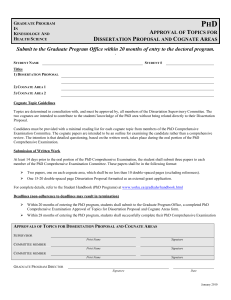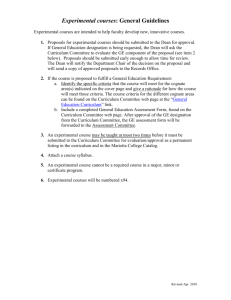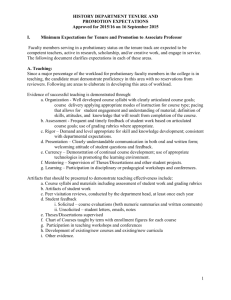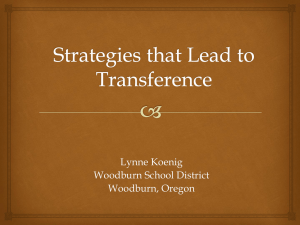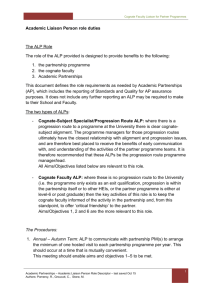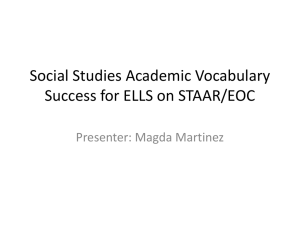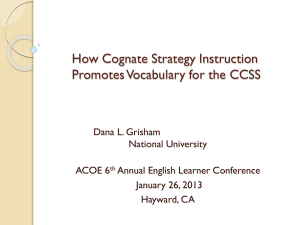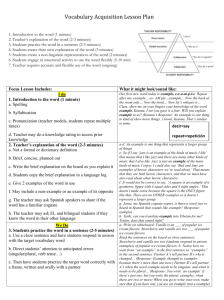Draft Draft COGNATE KNOWLEDGE The Cognate and False
advertisement
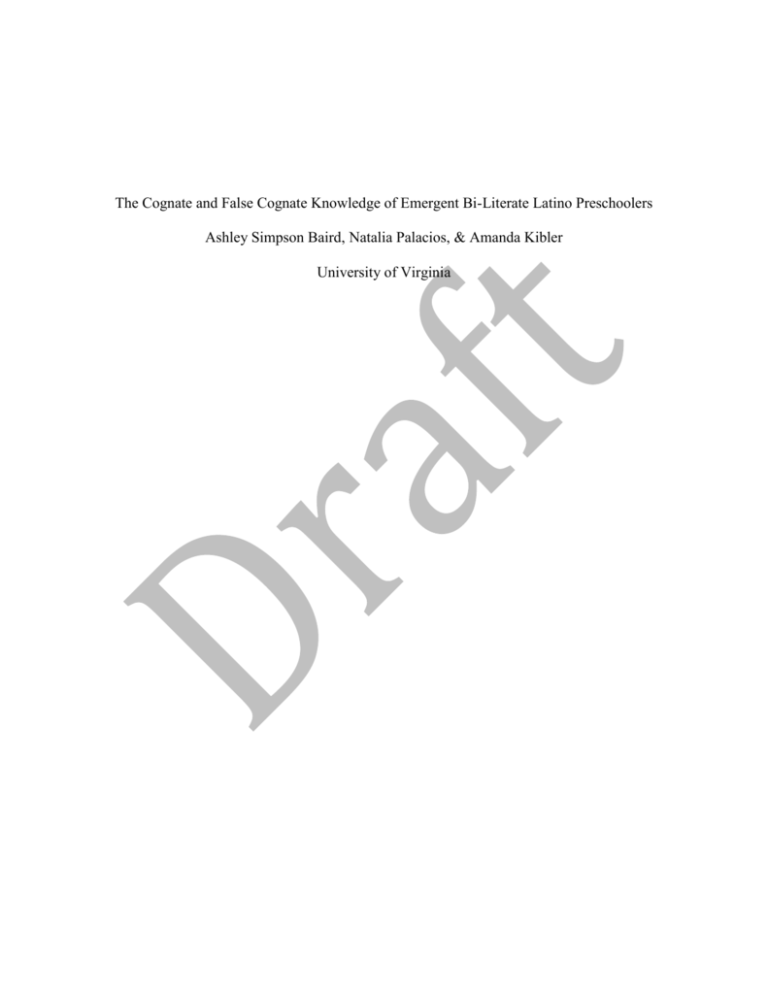
The Cognate and False Cognate Knowledge of Emergent Bi-Literate Latino Preschoolers Ashley Simpson Baird, Natalia Palacios, & Amanda Kibler University of Virginia COGNATE KNOWLEDGE 2 Abstract To understand emergent bi-literate, second-generation preschoolers cognate knowledge this study examined children’s (N = 80; M = 4 years, 7 months, SD = .86 years) cognate and false cognate item scores and vocabulary outcomes on four early language assessments in English and Spanish. Findings revealed that children who are just beginning to acquire literacy may also posses a “bilingual advantage” when identifying cognate items like their older peers (e.g. August et al., 2005; Carlo et al., 2004). However, in some cases, the relationships between cognate items and vocabulary outcomes were contradictory to the researchers’ expectations thus reflecting the complexity of the children’s emergent bilingualism. COGNATE KNOWLEDGE 3 The Cognate and False Cognate Knowledge of Emergent Bi-Literate Latino Preschoolers Introduction Cognates, or words that are semantically, phonologically, and/or orthographically similar between two languages, have been estimated to comprise between a third to as much as a half of the average, educated person’s vocabulary (August, Carlo, Dressler, & Snow, 2005). For bilinguals—particularly speakers of languages that share etymological roots such as English and Spanish—an understanding of cognates can prove beneficial. For instance, native Spanish speakers possess a unique linguistic potential because many everyday words in Spanish are considered academic words in English (e.g. acuerdo and accord; Bravo, Hiebert, & Person, 2005; Dressler, Carlo, Snow, August, & White, 2011). Moreover, an understanding of cognates has been shown to facilitate word recognition (Hoshino & Kroll, 2007) as well as aural and written comprehension (e.g. August et al., 2005; Carlo et al., 2004; Dressler et al., 2011; Jiménez, Garcia, & Person, 1996) for English-Spanish bilinguals. Yet the bulk of research on cognate transfer has been conducted with children and adults who have already acquired print literacy and therefore are likely have developed knowledge about the orthography of both their first and second languages as well as have more extensive vocabularies—both of which aid in their comprehension of cognates. There are very few studies that examine whether bilingual preschool age children—who are still building emergent literacy skills—possess an implicit understanding of the phonological and semantic overlaps that exist between certain words across languages. While it has been noted that literate bilingual children use sound similarities to identify cognates (Kieffer & Lesaux, 2008; Dressler et al., 2011), it is not fully understood if younger, emergent literate children also possess this understanding. Yet, the use of cognates in instruction is a frequently cited strategy for leveraging the linguistic COGNATE KNOWLEDGE 4 resources of bilingual students (e.g. Echevarría, Vogt, & Short, 2013). Considering the rapidly expanding population of preschool age children who grow up in homes where a language other than, or in addition to, English is spoken (Hernandez, Takanishi, & Marotz, 2009; Russakoff, 2011) a more nuanced of children’s cognate knowledge will prove beneficial in their transition to K-12 schooling. This paper details a study of the relationship between pre-school age Latino children’s cognate and false cognate knowledge and their vocabulary outcomes in order to understand whether or not young, emergent bi-literate children possess a cognate advantage in orally understanding and producing cognates in English and Spanish. Cognate Research: A “Bilingual Advantage” Substantial research documents that bilingual children—both those that have received formal instruction and those that have not—use cognate strategies to identify and understand words in English that are cognates in their first language. In other words, these children have access to a bilingual advantage or cognate facilitation effect that their monolingual peers do not possess. For instance, Jimenez, Garcia, and Pearson (1996) found that middle school aged, Latino bilingual students who were successful readers regularly used their Spanish language abilities to understand words in English. While this was in the absence of explicit instruction on the presence of cognates, research on teaching children about cognates has also proven successful. In one study, 5th-grade Spanish-speaking English language learners (ELLs) who had been taught to look for Spanish cognates in English texts were able to apply this strategy when inferring the meaning of an untaught cognate word more readily than a control group (Dressler, 2000). Yet the children were not always consistent in their application of this strategy, rather they applied it more frequently to words that were phonologically similar across languages (Dressler, 2000). Likewise, in an English academic vocabulary intervention study focused on COGNATE KNOWLEDGE 5 increasing children’s word inference skills—which included looking for English cognates of Spanish words—Carlo and colleagues (2004) found that 5th graders in the intervention group showed greater vocabulary growth than their peers in the control group. Similarly, in an another study of the relationship between first and second language reading skills—cognate transfer among them—August and colleagues (2006) found that English-Spanish bilingual 4th graders, receiving strategy instruction in Spanish, scored better on cognate items in English than their English speaking and bilingual peers—who were both instructed in English—on a researcherdeveloped measure of cognate awareness. The authors interpret this finding as evidence of the children’s ability to readily access their knowledge of vocabulary in Spanish to identify cognate pairs in English, yet they stress that first language literacy was necessary in order to take advantage of the cognate strategy (August et al., 2006). While Dressler’s (2000) findings hint at the potential for emergent literate children to rely on words’ shared phonology to recognize cognates, very few studies have confirmed this hypothesis, rather research has focused more on bilinguals who utilize the morphological and/or orthographic similarities between words. However, one study of bilingual speakers of languages that do not share orthography—in this case, English and Japanese—showed that children still use languages’ shared phonology to accurately identify cognates in English (Hoshino & Kroll, 2007). This bilingual advantage to recognize cognates can prove useful, especially for native Spanish speakers, since many high-frequency words in Spanish are considered academic words in English (Dressler et al., 2011; Lubliner & Heibert, 2011). For instance, an analysis of vocabulary words in three elementary school science topics (terrarium investigations, shoreline sciences, and designing mixtures) revealed that not only were 76% of the words English-Spanish cognates, but half of those cognates were high-frequency words in Spanish whereas only 13% of COGNATE KNOWLEDGE 6 the corpus were high-frequency words in English (Bravo, Hiebert, & Pearson, 2005). The authors of this study highlight the potential for English-Spanish bilingual children in learning science vocabulary and note that teachers should capitalize on this potential by explicitly drawing their students’ attention to these overlaps. Use of this instructional strategy has proven effective in increasing children’s growth in word knowledge, vocabulary, and reading comprehension (Carlo et al., 2004; Dressler et al., 2011). These facilitating effects have also been documented for school age children who are native English speakers in a Spanish immersion program (Cunningham & Graham, 2000). Most of the research on cognates has been conducted with elementary school age children who have some literacy in one or both languages. While there is evidence that the ability to accurately identify cognates develops with age and is facilitated by the acquisition of more vocabulary and more developed literacy (August et al., 2005; Hancin-Bhatt & Nagy, 1994), existing research begs the question of when children begin to leverage a potential bilingual advantage. Since younger bilinguals are not able to rely upon their knowledge of words’ shared orthography in recognizing cognates, they instead rely on cognate pairs’ overlapping phonology. One study comparing bilingual (English-Spanish) and monolingual (English) preschoolers revealed no differences in the identification of cognates and non-cognates in a receptive language task (picture identification). However, on a productive language task (picture naming), bilingual children demonstrated a higher accuracy for phonologically similar cognates than noncognates whereas their monolingual peers showed no differences (Leacox, 2011). Another study of native Spanish-speaking bilingual children enrolled in a dual language Kindergarten showed that students were able to infer the meaning of English cognate words and orally produce a COGNATE KNOWLEDGE 7 definition for target words when they had been explicitly taught their Spanish equivalents (Mulkern Ware, 2011). The above research on bilingual children’s cognate knowledge reveals three substantial gaps, all of which the present study strives to address. First, while there is evidence to suggest that emergent literate children might rely on phonology—in the absence of cognate instruction or more established literacy skills—to recognize cognate pairs, there is limited empirical evidence to back up this assertion. Second, there is no research on bilingual children’s false cognate knowledge, a more complex and cognitively demanding measure of bilingualism. Lastly, the above research is unidirectional, in other words it considers cognate transfer from Spanish (or another non-English language) to English. The present study conceptualizes language more broadly to recognize that bi- and multilingual speakers are constantly moving between and across languages in communication. Common Underlying Proficiency and Translanguaging Practices This study is informed by two theoretical frameworks that explicate how bilinguals leverage their linguistic repertoires. The common underlying proficiency hypothesis (CUP; Cummins, 1978, 1981, 1991, & 2000) explains how an individual accesses, processes, and stores linguistic information across languages. Translanguaging (Gracia & Wei, 2014) conceptualizes a bilingual speaker as being informed by the social practices that contribute to his or her linguistic knowledge base. The CUP posits that a bilingual speaker possesses foundational knowledge about language that is transferable across all of the languages that he or she speaks (Cummins 1978, 1981, 1991, & 2000). Specifically, Cummins (1991) notes that there are at least five types of cross-linguistic transfer that occur. These are (1) conceptual knowledge, (2) metacognitive and metalinguistic strategies, (3) pragmatics, (4) cross-linguistic elements, and (5) phonological COGNATE KNOWLEDGE 8 awareness. In relation to cognates, a bilingual speaker can leverage these transfer skills to decipher new and related words across languages. Like CUP, translanguaging recognizes that knowledge of any language is not an autonomous skill (Gracia, 2009). Yet, translanguaging goes beyond CUP to recognize that bilingual children appropriate language through their interactions with other bi- and monolingual speakers. Unlike CUP, translanguaging does not refer to a synthesis of knowledge across languages, but rather identifies new language practices that “make visible the complexity of language exchanges” (Garcia & Wei, 2014, p. 21). As participant researchers in the bilingual communities studied, the researchers regularly observe children’s translanguaging practices through their mixing of languages, code switching, and hybridizing of English and Spanish. While the present study examines only cognate and false cognate knowledge, the researchers have documented that the language abilities of the children from this sample have been shaped through the bilingual interactions in their homes and communities (reference withheld). Present Study This study analyzes the cognate and false cognate knowledge of native Spanish-speaking preschoolers living in the United States through answering the following questions: 1. Does emergent literate dual language learners’ cognate and false cognate understanding vary by language (English versus Spanish) and/or vocabulary type (receptive language versus productive language)? 2. Does cognate knowledge relate to receptive and/or productive language vocabulary outcomes in English or Spanish? 3. Does false cognate knowledge relate to receptive and/or productive language vocabulary outcomes in English or Spanish? COGNATE KNOWLEDGE 9 Through answering these questions, this study extends the extant literature on bilinguals’ cognate knowledge in that it (1) focuses on preschoolers—a growing population that has not been readily examined in terms of cognate knowledge, (2) examines potential bidirectional influence between English and Spanish, and (3) analyses children’s cognate as well as false cognate knowledge, the latter being a construct that is not documented in cognate research. Moreover, this study has several methodological strengths; first, the analyses include the use of nuanced controls that allow for the examination of each control variable’s influence upon the variable of interest. Second, this study is innovative for the way that it draws from several widely used vocabulary assessments as proxies for measuring bilingual children’s cognate and false cognate knowledge. Method Sample The data for this study come from a multi-phase, mixed methods study of 80 Latino families living in a new immigrant community in a South-Atlantic state. This community is located in a suburban area outside a small city, surrounded by rural, agricultural areas. Due to the small size of this community, the sample was one of convenience. The researchers recruited families through local preschool programs, social services agencies, and churches. On average, the families in this study had been in the U.S. for less than 9 years (M = 8.5 years, SD = 2.8, range = 1-14). At the time of data collection, no public bilingual educational services were offered, thus all children attended or will attend preschools where instruction is monolingual (English). Of the 80 children in the study, 28.4% attended pre-school. Given the monolingual orientation of education in and around this city, it is safe to assume that these children are not receiving substantial instruction that might help them to leverage a bilingual advantage as it relates to cognate knowledge. COGNATE KNOWLEDGE 10 However, these children (M = 4 years, 7 months, SD = .86 years), even those that have not yet entered school, are regularly exposed to both English and Spanish, but have a tendency towards speaking more Spanish than English in the homes. In the first phase of this study, families reported on their home language practices. Analyses of these data paired with in-home observations of children interacting with family members revealed that they are growing up in multilingual homes. For example, a child may use Spanish to speak to their mother, English to speak to an older brother, or a mix of the two when speaking to a younger sister. In this way, the term “emergent” refers to both the children’s emergent literacy skills as well as their emergent language abilities in both languages. On average, the children in this sample preformed below norms for their age-level in both the English and Spanish assessments used in the study (see Table 1). This study uses data from language assessments conducted with the preschool age children during the second of a three-phase study examining home language and literacy practices. Bilingual research assistants administered the language assessments orally in the children’s homes during 2012 and 2013. Measures and Procedures The assessments include measures in both Spanish and English: Test de Vocabulario de Imagenes Peabody (TVIP; Dunn, Padilla, Lugo, & Dunn 1986), Peabody Picture Vocabulary Test-4 (PPVT; Dunn & Dunn, 2007), and the picture vocabulary sub-tests of the WoodcockMuñoz Language Survey-Revised in English (W-ME; Woodcock, Muñoz-Sandoval, Ruef, & Alvarado, 2005a) and Spanish (W-MS; Woodcock, Muñoz-Sandoval, Ruef, & Alvarado, 2005b). As detailed in Table 2, the TVIP and PPVT examined children’s receptive language in Spanish and English, respectively. The picture vocabulary sub-test of the W-ME and W-MS COGNATE KNOWLEDGE 11 begin with receptive language questions, but switched to productive language tasks after the first or second question. For the purposes of this study, the PPVT and TVIP are considered measures of receptive language, whereas the W-ME and W-MS are measures of productive language. Research assistants administered all assessments according to their recommended protocols and in the language being assessed (PPVT and W-ME in English, TVIP and W-MS in Spanish). Each test began with four practice questions to assure that children understood the procedures. The PPVT and TVIP required that the research assistants read a word aloud while the child points to one of four pictures to indicate which picture goes with the stated word. In the WM-E and WM-S the researcher shows the child a picture and reads a scripted prompt such as, “What is this?” or “What is this called?” After the assessments were administered, individual items on the assessments were identified as cognates or false cognates using the Cross-linguistic Overlap Scale for Phonology (COSP; Kohnert, Windsor, & Miller, 2004; Kelley & Kohnert, 2012). The COSP is a tool used to assess a cognate or false cognate pair’s phonological overlap based upon the similarity of the two words’ initial sounds, syllables, consonants, and vowel sounds. For example, using the COSP, the pair circle-circulo is considered a phonological cognate where as airplane-avión is not. The circle-circulo pair would receive a score of 8 because the two words share an initial sound (3 points, out of 3), differ in number of syllables by one (1 point, out of 2), have a consonant overlap that is 70% or greater (3 points, out of 3), and have a vowel overlap that is between 50-80% (1 point, out of 2). Words with a COSP score of six or higher (out of ten) are considered to be phonological cognates or false cognates. Pairs that score 10 points are often orthographically the same word with only a slight difference in pronunciation, for example muffin-muffin and tornado-tornado would both receive 10 points on the COSP. In the instance COGNATE KNOWLEDGE 12 that a tested word had more than one equivalent in the other language (e.g. bola, pelota, or balón for ball) the word that was most phonologically similar—in other words, the word that would score highest in COSP analyses—was considered the tested word’s pair (e.g. balón). Table 3 contains examples of cognate and false cognate pairs from the administered assessments. Since this sample was composed of emergent bi-literate children, the COSP’s emphasis on words’ shared phonology—rather than orthography—proved an adequate fit for identifying words that children might recognize because they sound similar to words that they are familiar with in Spanish or English. The researchers calculated individual cognate and false cognate scores for each of the four assessments. These scores were a percentage of the number of cognate (or false cognate) items that a child answered correctly out of the number of cognate (or false cognate) items contained within the range of questions upon which each child was assessed. As outlined in further detail below, three variables were introduced into the analyses to control for other factors potentially influencing the children’s language exposure and development. The control variables included children’s gender, age, and number of older siblings. The third being a variable shown to influence English language exposure and development (e.g. Pérez-Granados, 2003; Baker, 2007; reference withheld). Both the children’s age and number of older siblings were continuous variables. Income was not used as a control due to a lack of variability among sampled families. Data Analyses The researchers conducted t-tests between the children’s cognate and false cognate scores in order to determine statistical significance in the differences between children’s cognate knowledge. Additionally, to understand if emergent dual language learners’ cognate knowledge was associated with receptive and/or productive language outcomes, the researchers analyzed COGNATE KNOWLEDGE 13 each cognate score’s relationship with each of the other vocabulary outcome scores save for the outcome score from which the variable of interest was derived. For example, TVIP cognate knowledge was not used to predict TVIP vocabulary knowledge, as the two variables are not independent. The researchers first used ordinary least squares (OLS) regression to model the association between the independent variable, children’s cognate knowledge, and their vocabulary score (vocabulary score on the PPVT, TVIP, W-ME, or W-MS). In subsequent models, the researchers included the statistical control variables (i.e., age, gender, and number of older siblings) in order to understand the relationship that each of these controls had on the association between cognate score and children’s vocabulary. In order to understand if emergent dual language learners’ false cognate knowledge was associated with receptive and/or productive language outcomes, the researchers conducted similar analyses examining the relationship between children’s false cognate knowledge and their scores on the vocabulary assessments. For example, the researchers examined the relationship between the children’s TVIP false cognate scores and their vocabulary outcomes on the PPVT, W-ME, and the W-MS, but not the TVIP. Missing data. Twenty-two percent of children were missing Woodcock-Muñoz picture vocabulary and letter-word identification scores in English and Spanish, assessed in phase 2 of the study, due to child attrition. Therefore the researchers used multiple imputation to address the missing data. Multiple imputation provides several benefits over single imputation techniques, such as mean imputation of missing data, as it provides better estimates of standard errors (Allison, 2000, 2001; Little & Rubin, 1989). However, for multiple imputation to be a useful tool for missing data, one must verify that data are missing at random (MAR), conditional on the additional covariates. Inspection of the data used for this analysis yields no clear pattern of COGNATE KNOWLEDGE 14 missingness (i.e., missingness on vocabulary was not positively related to other variables in the sample), thus satisfying the criteria for analysis. Multiple imputation with chained equations, particularly the “ice” command in Stata (v. 12 for Mac), was used to handle missing data (ICE; Royston, 2005). The resulting five imputed datasets were analyzed using the models described above. Results Cognate and False Cognate Knowledge In order to understand emergent biliterate preschoolers’ cognate knowledge, children’s cognate and false cognate scores were compared by language and task type (e.g., receptive and expressive vocabulary) (Table 4). Cognate knowledge. In comparing children’s cognate knowledge scores, t-tests indicated that in crosslanguage, within-task comparisons children more often identified cognates in English than in Spanish on receptive language tasks (t(79) = 2.51, p < .01), but showed no difference in identifying cognates in English and Spanish on productive language tasks. In within-language, cross-task comparisons children more often identified cognates on English receptive language tasks than on English productive language tasks (t(79) = 3.83, p < .001), but showed no difference in the frequency with which they identified cognates on Spanish receptive and productive language tasks. False cognate knowledge. In comparing children’s false cognate knowledge scores, t-tests indicate that in crosslanguage, within-task comparisons children more often identified false cognates in Spanish than English on receptive language tasks (t(79) = 2.98, p < .05), but children showed no difference in COGNATE KNOWLEDGE 15 the frequency with which they identified false cognates on productive language tasks in either language. In within-language, cross-task comparisons children showed no difference in the frequency with which they identified false cognates on either receptive or productive language tasks in both English and Spanish. Cognate versus false cognate knowledge. In comparing children’s cognate and false cognate knowledge scores, there were no differences in the frequency with which children identified receptive language cognate and false cognate items in neither English nor Spanish. Additionally, there was no difference in the frequency with which children identified cognate and false cognate items on Spanish productive language tasks. However, children more often identified false cognates than cognates on English productive language tasks (t(79) = 4.67, p < .001). Cognates and Vocabulary Outcomes In order to understand if emergent dual language learners’ cognate knowledge was associated with receptive and/or productive language outcomes, the researchers analyzed each cognate score’s relationship with each of the other vocabulary outcome scores. Table 5 reports the findings for each relationship both with and without statistical controls (age, gender, and older siblings). The only significant relationship in these analyses was found between the TVIP cognate score and vocabulary outcomes on the W-MS (B = 80.21, SE = 36.49, p < .05), and only after including the control variables, particularly controlling for older siblings. False Cognates and Vocabulary Outcomes In order to understand if emergent dual language learners’ false cognate knowledge was associated with receptive and/or productive language outcomes, the researchers analyzed each false cognate score’s relationship with each of the other vocabulary outcome scores. Table 6 COGNATE KNOWLEDGE 16 reports the findings of each model, both with and without statistical controls. Results indicated that four relationships were significant. These relationships existed both between and across languages. First, examining the within language relationships, the W-ME false cognate score was a significant predictor of vocabulary outcomes on the PPVT (B = 28.59, SE = 9.38, p < .05). The predictor variable was significant in the initial model and continued to be significant when controlling for both the children’s gender and age. Likewise, in Spanish, the TVIP false cognate score was a significant predictor of vocabulary scores on the W-MS picture vocabulary test (B = 74.20, SE = 28.74, p < .05). Again the predictor variable was significant in the initial model and continued to be significant when controlling for the children’s gender and their number of older siblings. Second, in examining the cross-language relationships, the W-MS false cognate score was a significant negative predictor of vocabulary outcomes on the PPVT (B = -33.69, SD = 15.86, p < .05). The predictor variable was significant only when controlling for the children’s age. It is also important to note that the coefficient of the predictor variable is negative in every model. Lastly, the PPVT false cognate score was a significant predictor of vocabulary scores on the TVIP (B = 10.63, SD = 5.16, p < .05). Again, the predictor variable was significant only once controlling for the children’s age. Conclusions Q1: Does emergent literate dual language learners’ cognate and false cognate understanding vary by language (English versus Spanish) and/or vocabulary type (receptive language versus productive language)? In summary, this study reveals that emergent bi-literate preschoolers’ cognate knowledge follows somewhat predictable patterns in that their Spanish receptive cognate knowledge was COGNATE KNOWLEDGE 17 about the same as their Spanish productive cognate knowledge—perhaps indicating a more extensive vocabulary in Spanish more than transfer from English to Spanish. As well, children’s English receptive cognate knowledge exceeded their English productive cognate knowledge indicating a normal trend in language development where receptive language exceeds productive language (Gibson, Oller, Jarmulowicz, & Ethington, 2012). Additionally, the children’s English receptive cognate knowledge exceeds their Spanish receptive cognate knowledge indicating that children may be transferring Spanish word knowledge to English more readily than from English to Spanish. Yet, somewhat surprising is that their English and Spanish productive cognate knowledge is about the same. Predictable patterns also emerged in the children’s false cognate knowledge in that their Spanish receptive knowledge was about the same as their productive knowledge, their English receptive knowledge was about the same as their English productive knowledge, and their Spanish receptive knowledge exceeded their English receptive knowledge. Yet surprisingly, Spanish productive knowledge was about the same as English productive knowledge—a finding that the researchers did not expect given the children’s higher proficiency in and greater exposure to Spanish. Q2: Does cognate knowledge relate to receptive and/or productive language vocabulary outcomes in English or Spanish? In examining the relationships between children’s cognate knowledge and their vocabulary outcomes, this study found that cognate scores on receptive language tasks in Spanish were significant predictors of children’s productive language outcomes in Spanish. Again this association reflects a natural developmental progression where comprehension of language exceeds the ability to produce it (Gibson et al., 2012). COGNATE KNOWLEDGE 18 Q3: Does false cognate knowledge relate to receptive and/or productive language vocabulary outcomes in English or Spanish? While there was only one significant relationship between cognate scores and vocabulary outcomes, children’s false cognate scores turned out to more readily predict their vocabulary outcomes. Table 7 contains a summary of the findings for false cognate knowledge as predictors of vocabulary outcomes. When examining the relationships within languages, this study revealed that in Spanish—the language most commonly spoken in the children’s homes—receptive false cognate knowledge was a significant predictor of productive language vocabulary outcomes. Similar to our finding for cognate knowledge, this result follows a typical course of language development (Gibson et al., 2012). However, given the above findings of the children’s cognate and false cognate knowledge across receptive and productive language tasks, one might expect the children’s productive false cognate knowledge in Spanish to predict their Spanish receptive language vocabulary outcomes, yet this relationship was not found to be significant. However, examining the within language relationships in English—the language most commonly spoken outside of the children’s homes—productive false cognate knowledge predicts receptive vocabulary outcomes. Given this finding, the researchers expected that the children’s English false cognate knowledge on receptive language tasks would predict their English productive language vocabulary outcomes, yet this relationship was not found to be significant. In examining the children’s cross-language relationships between false cognate knowledge and vocabulary outcomes, this study’s findings revealed first that English false cognate knowledge on receptive language tasks was a significant predictor of Spanish receptive language vocabulary outcomes. These findings also revealed that children’s Spanish false cognate knowledge on productive language tasks was a significant negative predictor of English COGNATE KNOWLEDGE 19 receptive language vocabulary outcomes. These two findings are evidence to suggest that children might be using their more dominant language (Spanish) to effectively to understand their less dominant language (English), but not vice versa. Discussion Taken collectively, the above findings reveal interesting patterns in emergent bilingual children’s language development. These analyses show that emergent literate bilingual children are able to identify cognates and false cognates in both English and Spanish and that this knowledge is associated with both within- and cross- language vocabulary outcomes. Moreover, these findings are evidence in support of the notion that bilingual children who are in the process of acquiring print literacy may also possess a bilingual advantage in recognizing and producing cognate words in both languages like their older, literate peers (e.g. August et al., 2005; Dressler et al., 2011; Carlo et al., 2004; Jiménez et al., 1996). Yet, results indicate that children’s cognate and false knowledge was somewhat inconsistent and perhaps not what one might anticipate. First, it is interesting that the children’s cognate knowledge was not as predictive of their vocabulary outcomes as was their false cognate knowledge. This is striking because of the differential cognitive demands that cognates and false cognates make upon a language user, with the recall of cognates being a less cognitively demanding task than that of false cognates. Perhaps the reason that false cognate knowledge was found to be more predictive of vocabulary outcomes is because of the authentic feedback that children receive from using false cognates in interactions. For instance, if a child says, “I want to go in the bark,” when he means that he wants to go in a boat (barco being a false cognate for boat), it might result in correction of the error and therefore an opportunity for authentic learning. The same could not be said for the children’s use of cognates because they would not COGNATE KNOWLEDGE 20 be considered errors and therefore would not be reinforced nor corrected. Moreover, the findings of this study are evidence of the variable nature of the children’s developing bilingual language proficiency, whose linguistic knowledge—when measured at any single time point—is reflective of a complex and continuously adapting system. Complexity theory conceptualizes these shifts in language and a language learner’s developing repertories in the following way: language as a complex adaptive system, which emerges bottom-up from interactions of multiple agents in speech communities, rather than a static system composed of top-down grammatical rules or principles. The system is adaptive because it changes to fit new circumstances, which are also themselves continually changing. (Larsen-Freeman, 2011, p. 49) From the standpoint of complexity theory, one would not expect emergent bilingual children to progress through lockstep, measureable stages of language acquisition where the entirety of linguistic knowledge can be captured. Rather, these children’s knowledge is both unique to each individual and also constantly changing. As mentioned above, the children in this study operate in environments that are marked by translingual interactions, or as Garcia (2009) describes, “the fluid language practices of bilinguals” (p. 1) that do not give up the social construction of language and bilingualism under which speakers operate. In working with this population, the researchers have noticed that the children’s fluidity—between and across languages—is a characteristic trait of the families in the study. In this way, it is not surprising that children’s bilingual knowledge may also be fluid. Moreover, these children exist in a community whose language practices are continually shifting and expanding. For instance, in the past year one of the local elementary schools that many children in this sample will attend implemented a COGNATE KNOWLEDGE 21 bilingual education program in their Kindergarten classes with the intention of expanding it to upper grades in the coming years. While this study examines one time point of language assessments, it is safe to assume that as these children age and enter school, the entirety of their linguistic knowledge will grow and therefore the relationships between their cognate knowledge and vocabulary outcomes will continue to shift. Limitations A limitation of this study is that the vocabulary assessments utilized were not designed to specifically measure cognate knowledge. However, to the knowledge of the researchers, a valid, norm-referenced measure of emergent literate children’s cognate knowledge does not yet exist, therefore a proxy was required. Additionally, the small size of this new immigrant community limited the number of children in the sample. Practical Implications Using cognates to instruct school-age English language learners is often recommended as a strategy for teachers, even those who are not fluent speakers of their students’ first languages. The findings of this study demonstrate that preschool age children may already be applying cognate strategies in the absence of instruction. Comparing this finding against evidence in support of the use of cognate strategy instruction for pre-school age children (Leacox, 2011; Mulkern Ware, 2011), suggests that children may already have an awareness of cognates prior to instruction. Additionally, children’s false cognate knowledge may also be an untapped resource for facilitating vocabulary development as these findings have shown that bilingual children are not confused by words that sound the same in in two languages. Moreover, this study reveals that there can be potential cross-linguistic benefits for children in that both cognate and false cognate instruction can support vocabulary development COGNATE KNOWLEDGE 22 across languages. To support young children’s language development, teachers and caregivers should make children aware of the similarities as well as the distinctions between words in each of the languages that children speak. Future Research The work of understanding emergent bilingual children’s linguistic knowledge is far from complete. This study brings up more questions about how children growing up in bi- and multilingual communities acquire multiple languages and what relationships exist within the entirety of their linguistic repertoires. Yet the need for this knowledge has never been more pressing. The growing the population of children in American public schools who speak home languages in addition to English demands an understanding of how to instruct and support biand multilingual learners. Future research with this population should continue to document relationships between and across languages. More specifically, future cognate research with this population should strive to explain relationships between children’s false cognate knowledge and their vocabulary outcomes and the processes that facilitate these relationships. While the researchers were able to document these trends and speculate about their meanings, it would be helpful for future studies to address why they exist and how they might be leveraged in instruction. Future research should examine whether or not these findings hold for children growing up in speech communities where other languages, besides Spanish, are spoken. Finally, future research should examine children’s cognate and false cognate knowledge as well as the relationship that each of these has to vocabulary development over time. COGNATE KNOWLEDGE 23 References Allison, P. (2000). Multiple imputation for missing data: A cautionary tale. Sociological Methods Research, 28, 301-309. doi: 10.1177/0049124100028003003. Allison, P. (2001). Missing Data. Sage University Paper. August, D., Carlo, M., Dressler, C, & Snow, C. (2005). The critical role of vocabulary development for English language learners. Learning Disabilities Research & Practice, 20(1), 50-57. doi: 10.1111/j.1540-5826.2005.00120.x. August, D., Snow, C., Carlo, M. Proctor, P., Rolla de San Francisco, A., Duursma, E., & Szuber, A. (2006). Literacy development in elementary school second-language learners. Top Language Disorders, 26(4), 351-364. doi: 10.1097/00011363-200610000-00007. Baker, C. (2007). A parents’ and teachers’ guide to bilingualism, 3rd ed. Clevedon, UK: Multilingual Matters. Bravo, M.A., Hiebert, E.H., & Pearson, P.D. (2005). Tapping the linguistic resources of Spanish/English bilinguals: The role of cognates in Science. In R.K. Wagner, A. Muse, & K. Tannenbaum (Eds.), Vocabulary development and its implications for reading comprehension. New York: Guilford. Carlo, M.S., August, D., McLaughlin, B., Snow, C., Dressler, C., Lippman, D.N., Lively, T.J., & White, C.E. (2004). Closing the gap: Addressing the vocabulary needs of English language learners in bilingual and mainstream classrooms. Reading Research Quarterly, 39(2), 188-215. doi: 10.1598/RRQ.39.2.3. Cummins, J. (1978). Educational implications of mother tongue maintenance for minority language groups. Canadian Modern Language Review, 34, 395-416. COGNATE KNOWLEDGE 24 Cummins, J. (1981). The role of primary language development in promoting educational success for language minority students. In California State Department of Education (Ed.), Schooling and language minority students: A theoretical framework. Los Angeles, CA: Evaluation, Dissemination and Assessment Center California State University. Cummins, J. (1991). Interdependence of first- and second- language proficiency in bilingual children. In E. Bialystok (Ed.), Language processing in bilingual children (pp. 70-89). New York: Cambridge. Cummins, J. (2000). Language, power, and pedagogy: Bilingual children in the crossfire. Clevedon, England: Multilingual Matters. Cunningham, T.H. & Graham, C.R. (2000). Increasing native English vocabulary recognition through Spanish immersion: Cognate transfer from foreign to first language. Journal of Educational Psychology, 92(1), 37-49. doi: 10.1037/0022-0663.92.1.37. Dressler, C. (2000). The word-inferencing strategies of bilingual and monolingual fifth graders: A case study approach. Unpublished qualifying paper, Harvard Graduate School of Education, Cambridge, MA. Dressler, C., Carlo, M.S., Snow, C.S., August, D., & White, C.E. (2011). Spanish-speaking students’ use of cognate knowledge to infer the meaning of English words. Bilingualism: Language and Cognition, 14, 243-255. doi: 10.1017/S1366728910000519. Dunn, L.M. & Dunn, D.M. (2007). Peabody Picture Vocabulary Test, Fourth Edition. New York: Pearson. Dunn, L.M., Padilla, E.R., Lugo, D.E., & Dunn, L.M. (1986). Test de Vocabulario de Imagenes Peabody. Minneapolis, MN: Pearson. COGNATE KNOWLEDGE 25 Echevarría, J., Vogt, M., & Short, D.J. (2013). Making content comprehensible for English leaners: The SIOP model, 4th Ed. Upper Saddle, NJ: Pearson. Garcia, O. (2009). Bilingual education in the 21st century: A global perspective. Oxford: WileyBlackwell. García, O. (2011). The translanguaging of Latino kindergartners. In K. Potowski & J. Rothman (Eds.) Bilingual youth: Spanish in English-speaking societies (pp. 33-56). Philadelphia, PA: John Benjamins. Garcia, O. & Wei, L. (2014). Translanguaging: Language, bilingualism, and education. Basingstoke, UK: Palgrave MacMillan. Gibson, T.A., Oller, K., Jarmulowicz, L., & Ethington, C.A. (2012). The receptive-expressive gap in vocabulary of young second-language learners: Robustness and possible mechanisms. Bilingualism: Language and cognition, 15(1), 102-116. doi: 10.1017/S1366728910000490. Hancin-Bhatt, B. & Nagy, W.E. (1994). Lexical transfer and second language morphological development. Applied Psycholinguistics, 15(3), 289-310. Hernandez, D.J., Takanishi, R., & Marotz, K.G. (2009). Life circumstances and public policies for young children in immigrant families. Early Childhood Research Quarterly, 24, 487501. doi: 10.1016/j.ecresq.2009.09.003. Hoshino, N. & Kroll, J.F. (2007). Cognate effects in picture naming: Does cross-language activation survive a change of script? Cognition, 106, 501-511. Doi: 10.1016/j.cognition.2007.02.001. COGNATE KNOWLEDGE 26 Jiménez, R.T., García, G.E., & Pearson, P.D. (1996). The reading strategies of bilingual Latina/o students who are successful English readers: Opportunities and obstacles. Reading Research Quarterly, 31(1), 90-112. doi: 10.1598/RRQ.31.1.5. Kelley, A. & Kohnert, K. (2012). Is there a cognate advantage for typically developing Spanishspeaking English language learners? Language, Speech, and Hearing Services in Schools, 43, 191-204. doi: 10.1044/0161-1462(2011/10-0022). Kohnert, K., Windsor, J., & Miller, R. (2004). Crossing borders: Recognition of Spanish Words by English-speaking children with and without language impairment. Applied Psycholinguistics, 25(4). doi: 10.1017/S0142716204001262. Kieffer, M.J. & Lesaux, N.K. (2008). The role of derivational morphology in the reading comprehension of Spanish-speaking English language learners. Reading and Writing, 21, 783-804. doi: 10.1007/s11145-007-9092-8. Larsen-Freeman, D. (2011). A complexity theory approach to second language development/acquisition. In D. Atkinson (Ed.) Alternative approaches to second language acquisition (pp. 48-72). New York: Routledge. Little, R.A., & Rubin, D.B. (1989). The analysis of social science data with missing values. Sociological Methods Research, 18, 292-326. doi: 10.1177/0049124189018002044. Leacox, L. (2011). Young English learners' cognate sensitivity on picture-word recognition and production. Electronic Theses, Treatises and Dissertations. Paper 5767. http://diginole.lib.fsu.edu/etd/5767. COGNATE KNOWLEDGE 27 Lubliner, S. & Heibert, E.H. (2011). An analysis of English-Spanish cognates as a source of general academic language. Bilingual Research Journal, 34, 76-93. doi: 10.1080/15235882.2011.568589. Mulkern Ware, S. (2011). The role of cognates in bilingual kindergartners’ vocabulary development. Doctoral Dissertations. Paper AAI3492124. http://digitalcommons.uconn.edu/dissertations/AAI3492124. Pérez-Granados, D.R. (2002). Normative scripts for object labeling during a play activity: Mother-child and sibling conversations in Mexican-descent families. Hispanic Journal of Behavioral Sciences 24(2), 164-190. doi: 10.1177/0739986302024002004. Royston, P. (2005). Multiple imputation of missing values: Update. The Stata Journal, 5, 1-14. Russakoff, D. (2011). PreK-3rd: Raising the educational performance of English language learners (ELLs). PreK-3rd Policy Action Brief. New York, NY: Foundation for Child Development. Woodcock, R.W., Muñoz-Sandoval, A.F., Ruef, M.L., & Alvarado, C.G. (2005a). WoodcockMuñoz Language Survey-Revised, English. Rolling Meadows, IL: Riverside Publishing. Woodcock, R.W., Muñoz-Sandoval A.F., Ruef M.L. & Alvarado, C.G. (2005b). WoodcockMuñoz Language Survey-Revised, Spanish. Rolling Meadows, IL: Riverside Publishing. Table 1 Descriptive sample characteristics Percent Mean (SD) Range Age Equivalence Score Dependent variables: PPVT vocabulary scores TVIP vocabulary scores W-ME vocabulary scores 44.12 (26.90) 24.90 (16.11) 415.40 (26.80) 3 years, 2 months 4 years, 3 months 2 years, 6 months W-MS vocabulary scores 435.241 (32.67) 0-118.76 0-68.29 356.98481.33 341.50502.47 Control variables: FC age (months) Female Number of older siblings 55.89 (10.30) 27.51-77.49 1.27 (1.05) 0-4 58% 2 years, 11 months COGNATE KNOWLEDGE 29 Table 2 Measures of receptive and productive language in English and Spanish English Spanish Receptive language measure Peabody Picture Vocabulary Test de vocabulario de Test-4 (PPVT) imágenes Peabody (TVIP) Productive language measure Woodcock-Muñoz Language Survey-Revised, Picture Vocabulary (W-ME) Woodcock-Muñoz Language Survey-Revised, Picture Vocabulary (W-MS) COGNATE KNOWLEDGE Table 3 Examples of cognate and false cognate pairs from COSP analyses. Cognate pairs False cognate pairs lamp lámpara bark barco penguin pingüino code codo tunnel túnel goat gota diamond diamante root ruta calendar calendario red red 30 COGNATE KNOWLEDGE 31 Table 4 Descriptive data on cognate and false cognate scores Language domain Cognate scores English Receptive PPVTa M SD Range 65% 22% 0-100% English Productive Spanish Receptive W-MEb TVIPc 50% 57% 34% 17% 0-100% 0-93% Spanish Productive 56% 19% 0-100% English Receptive English Productive W-MSd False cognate scores PPVTe W-MEf 68% 64% 36% 36% 0-100% 0-100% Spanish Receptive TVIPg 57% 22% 0-100% Spanish Productive *p < .05, **p < .001 W-MSh 58% 20% 0-95% T-score comparisons a > b, t(79) = 3.83** a > c, t(79) = 2.51* a > e, t(79) = .68 b > d, t(79) = 2.21 c > d, t(79) = .28 c > g, t(79) = .64 d > h, t(79) = .74 e > f, t(79) = .61 f > b, t(79) = 4.67** f > h, t(79) = 1.18 g > e, t(79) = 2.98* g > h, t(79) = .61 COGNATE KNOWLEDGE 32 Table 5 Cognate scores predicting vocabulary outcomes on the PPVT, TVIP, W-ME, & W-MS. Outcome: PPVT TVIP W-M English W-M Spanish PPVT cognate -4.88 (8.48) -14.94 (21.21) 7.97 (19.48) PPVT cognate + controls TVIP cognate -- 3.43 (8.34) -19.25 (20.39) 4.34 (18.63) 21.03 (24.03) -- -24.48 (20.02) 81.20 (34.65) TVIP cognate + controls W-ME cognate 3.90 (21.26) -- -37.42 (20.84) 80.21 (36.49)* 11.09 (11.10) -2.44 (7.21) -- -6.93 (16.06) W-ME cognate + controls W-MS cognate 11.81 (9.14) -4.10 (6.51) -- -9.84 (14.90) 11.46 (20.88) 16.98 (11.12) -14.71 (18.98) -- -12.97 (19.57) -- W-MS cognate + 13.62 (18.18) 19.92 (11.48) controls *p < .05 Note. Controls = age, gender, number of older siblings COGNATE KNOWLEDGE 33 Table 6 False cognate scores predicting vocabulary outcomes on the PPVT, TVIP, W-ME, & W-MS. Outcome: PPVT TVIP W-M English W-M Spanish PPVT false -9.84 (5.18) -8.21 (12.62) 17.56 (15.84) cognate PPVT false cognate + controls TVIP false cognate -- 10.63 (5.16)* -6.36 (13.16) 16.81 (14.84) -.21 (17.98) -- .45 (19.34) 72.83 (27.42)* TVIP false cognate + controls W-ME false cognate -16.53 (16.23) -- -9.39 (17.24) 74.20 (28.74)* 36.10 (8.95)** 2.70 (5.53) -- 4.31 (11.73) W-ME false cognate + controls W-MS false cognate 28.59 (9.38)* -3.66 (6.31) -- -4.77 (12.32) -31.59 (19.89) 19.80 (10.98) -9.35 (27.94) -- -11.63 (26.27) -- W-MS false -33.69 (15.86)* 18.98 (9.26) cognate + controls *p < .05, **p < .001 Note. Controls = age, gender, number of older siblings COGNATE KNOWLEDGE Table 7 Summary of false cognate knowledge as a predictor of vocabulary outcomes. Receptive language Productive language vocabulary vocabulary English Spanish English Spanish False cognate English -+ 0 0 receptive Spanish 0 -0 + False cognate English + 0 -+ productive Spanish 0 0 -Key: + positive significant relationship; - negative significant relationship; 0 no relationship; 0 expected relationship. 34

